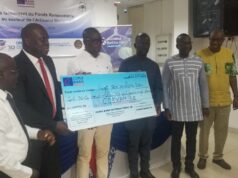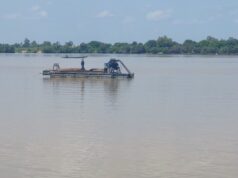Gold panning is one of the largest providers of employment in Burkina Faso with more than one million people, according to figures from the ministry in charge of mines. The country counted 400 sites in 2017, 60% of which are found in the South-West region. However, this activity is carried out, for the most part, in disregard of the laws on the subject. A “lucrative” business that pushes farmers in the southwest of Burkina, a watered region with fertile land, to give up their cultivable land to gold miners.
Ditonté Da is a rich landowner in the commune of Gbomblora. Now in his sixties and a widower, he has given up dozens of hectares of his land to gold miners. While he acknowledges that some of this land was given up voluntarily, he denounces the attitude of some gold miners who often go beyond the space that was given to them. “I am not fortunate enough to have a son and with old age, I am not able to exploit all my land. So I gave up part of it for mining and in return I get compensation. But the problem is that sometimes gold miners do not respect the original contracts,” he says in disappointment.
“We can wake up one morning and find that someone is digging holes on our land. Often, the gold digger is even on the site for months without the landowner being informed and without a permit to operate,” said Tiduonté Da, a landowner on the Korgo gold site, about 18 kilometers from Gaoua, who admits that it is difficult to control the gold diggers. He notes that sometimes it is when the world rushes to the site that the landowner realizes this and now undertakes negotiations for an exploitation contract.
According to Gaililou Sibalo, Secretary General of the Regional Chamber of Agriculture of the Southwest (CRA-Southwest), gold panning has negative consequences for the environment. The environmental impacts are linked in particular to deforestation with the cutting of trees, the trunks being used to prop up the galleries.
This deforestation has, among other consequences, the loss of vegetation cover and the physical degradation of soils. “The physical degradation of soils makes them unsuitable for agricultural production and grazing with regard to the turning over of the topsoil making the layers accessible to the roots of crops very poor in nutrients. The creation of sometimes deep holes and galleries reduces the exploitable areas,” notes the secretary general of the CRA.
50% of the sites are on cultivable land
The Chamber goes on to point out that this land degradation is, for the majority of cases, definitive since rehabilitation is generally not done, even for sites with an operating permit. In 2019, the General Directorate of Mining Cadastre and Information counted more than 71 sites in the South-West region. The regional director in charge of agriculture in the South-West, Sansan Jules Benoît Dah, said that less than 8% of these sites are formalized. For him, the consequences on the agro-sylvo-pastoral sector are undeniable since more than 50% of the sites are on cultivable land (one of the particularities of the region’s soils is that even the hills are favorable to the production of fruit trees).
“This situation undoubtedly has an impact on food and nutritional security in the region,” he said. Although his directorate does not have a study on the phenomenon, Sansan Jules Benoît Dah recognizes that gold panning contributes to the decline in agricultural production due to the extensive nature of agricultural production systems. “The reduction in agricultural production results in a reduction in food supply, which can lead to a rise in the price of agricultural products. The soaring prices of agricultural products contribute, in turn, to an increase in the vulnerability of households to food and nutritional insecurity,” said the regional director in charge of agriculture.
Samy Kambiré is a farmer in the village of Loto, about ten kilometers from Diébougou. He reluctantly sold dozens of hectares of his land. “We used to produce millet and maize with enough crops to feed us until the new season. But one day, we noticed a strong presence of gold miners on our land, claiming that they have a mining permit. We had no choice but to split up and sell each portion for 50,000,000 francs,” says Mr. Kambiré. Today, he continues, “we need land to cultivate, but we no longer have any and the money is also gone”.
The 2018 decree on the organization of artisanal and semi-mechanized mining of gold and other precious substances entrusts the National Agency for the Supervision of Artisanal and Semi-Mechanized Mining (ANEEMAS) with the formalities relating to artisanal mining activities, in particular the mining permit. It specifies that any person wishing to undertake an activity related to artisanal gold mining must hold a mining artisan card issued by ANEEMAS. In Article 9, the decree authorizes ANEEMAS to temporarily grant certain site management activities not covered by an operating permit to individuals on the basis of an agreement.
Adama Sawadogo has been an artisanal gold miner since 2006. This former farmer in the Yatenga province has become a gold miner. During the rainy season, when artisanal gold mining is suspended in the region, he and his colleagues spend most of their time twiddling their thumbs at the Korgo site market. He explains their approach: “We work informally. We go around the bush and when we come across a piece of land rich in gold, we try to meet the owner. The owner will tell us his conditions and show us the limits to exploit. If it happens that we want to go beyond his limits, we get in touch with him once again. While he acknowledges that some operators have permits, Adama notes that others do not.
Of the carelessness of the landowners
On this subject, the president of the National Union of Mining Craftsmen Associations of Burkina (UNAAMB), Mamadou Sawadogo: “I can assure you that in the South-West region, the sites that have authorizations are fewer. In the province of Poni, they do not exceed three or four”. He, who has thirty years of experience in gold panning, attributes this situation to the lack of collaboration between the companies that hold research permits and the operators. Mamadou Sawadogo explains that the request for a mining permit on an area covered by a research permit is subject to the opinion of the permit holder. In most cases, the latter do not give their consent because as soon as the area is invaded by gold miners, it is difficult for them to recover it for industrial or semi-mechanized exploitation.
This state of affairs is also noted by the Court of Accounts in its audit report on the compliance of research permits. The Court mentions the difficulty permit holders have in gaining access to their sites occupied by gold miners, often with the authorization of ANEEMAS. It explains this situation by the lack of synergy of actions between ANEEMAS and the General Directorate of the Mining Registry. At the level of ANEEMAS, the non-application of the texts is explained by various reasons. According to the Director General of the agency, Jacob Ouédraogo, these are ignorance and the high rate of illiteracy of the actors, the weak support of the State and the weak deconcentration of its structure. In addition to these are the insufficient adhesion of mining artisans to the vision of the mining administration, the inadequacy of some texts, the difficult collaboration of the defense and security forces, the lack of synergy of actions between the various actors involved in the artisanal gold mining. In addition, he maintains that his agency conducts training on good practices of artisanal gold mining but also collection of rehabilitation bonds.
In addition to the dysfunctions in the application of the laws, the president of UNAAMB denounces the behavior of certain landowners who “don’t care” about the fate of their land after exploitation. “Nowadays, when gold is discovered, it is the landowners who want to appropriate the management of the sites while ignoring the consequences. They do not seek to know if the operators have a permit or not, but it is the money that interests them,” he says. Under these conditions, says Mamadou Sawadogo, it is difficult to operate responsibly and the environment pays a heavy price with soil degradation and land pollution.
According to the regional director in charge of agriculture, soil and water pollution is due to the use of mercury and cyanide on gold panning sites. And this pollution has consequences on the sanitary quality of agro-pastoral products due to the use of polluted soil and water in agricultural and pastoral production. But Mr. Dah reassures that his management is sensitizing producers/landowners to the consequences of gold panning on cultivable land, a legacy to be passed on to their offspring.
All things considered, the decree on the organization and artisanal exploitation of gold indicates in Article 30 that “artisanal and semi-mechanized mining sites must be rehabilitated during and/or at the end of exploitation. The document grants rehabilitation, among others, to the holder of the mining permit and the holder of the management agreement for artisanal mining sites. In addition, ANEEMAS is responsible for abandoned sites.
“Without cultivable land …”
A presidential decree dated February 1, 2017, moreover, creates a “Fund for the rehabilitation, securing of artisanal mining sites and the fight against the use of chemicals.” Among the expenses covered by this fund are those related to “closure and rehabilitation works of artisanal mining sites at the end of exploitation or abandoned”. According to the distribution key defined by the interministerial decree n°2019-553/MEEVCC/MMC/MINEFID/MESCU of October 30, 2019, 60% of the Fund is reserved for these works.
But what about on the ground? “There is no rehabilitation after exploitation. The problem is that after exploitation, no one can even talk to anybody about rehabilitation,” says the landowner Tiduonté Da. His opinion is shared by Mamadou Sawadogo of UNAAMB, who believes that the absence of authorizations for the sites does not allow for the location of responsibility for rehabilitation. Agreeing with him, Titonté Da maintains that after the work of artisanal miners, the space becomes impractical for agriculture. “The gold miners only look at their gain but not at the destruction they cause to our soils. However, without cultivable land, we will not have enough to feed our families. The money that is paid to us by the gold miners is not enough for our needs,” he says.
In the contracts between the operators and the owners, it appears that the latter receive between 50,000 and 100,000 FCFA for each hole dug. In addition, they recover at least one out of every ten bags of minerals extracted. Adama Sawadogo admits that the rehabilitation of the sites is the least of their concerns. On Route Nationale 12 (RN12), from Gaoua to Batié via Gbomblora, abandoned gold panning sites are multiple. “After we leave a site, it is the rain that closes the holes for us. It also happens that we close the shallowest holes,” says the man who says he has worked on most of the gold panning sites around Gbomblora.
On the question of rehabilitation, the answer of the ANEEMAS DG is clear: “To date, we do not have any examples of rehabilitation in Burkina Faso. However, we do have an administrative framework and qualified technicians”. Jacob Ouédraogo justifies this situation by the lack of financial resources, the difficulties to carry out the inventory of the abandoned sites or at the end of exploitation, the non-operation of the rehabilitation fund.
The people of the region are calling for better organization of the gold panning sites in order to preserve their land. For Tiduonté Da, the activity of gold panning feeds millions of people. The consequences of banning it will therefore be numerous. “We have no choice but to live with it. However, we call on the authorities to carry out awareness-raising and actions to rehabilitate the sites after exploitation,” pleads the landowner. A farmer in Loto, Guékouma Dabiré explains that there are parts that the gold miners have abandoned in search of gold in other localities. We cultivated there, he says, but the plants struggled to grow, unlike the land where no gold panning was done. “In reality, we cultivate in spite of ourselves, otherwise we don’t earn much, it’s as if gold panning has taken all the fertility of our land,” confesses Mr. Dabiré.
According to Mamadou Sawadogo, mining artisans associations are working on a project to rehabilitate the sites at the end of their operations. CRA-South-West recommends, for its part, the vigorous application of laws on environmental protection, the sensitization of mining agents and their organizations on good practices in gold mining, but also the realization of a study to evaluate land losses caused by the activity. ANEEMAS suggests that artisans could be organized into cooperatives in order to facilitate state support.
Jacob Ouédraogo also invites the State to create corridors or areas specifically dedicated to the artisanal miners. “The administration of mines through ANEEMAS is engaged in a process of reorganization and securing the activities of artisanal gold mining. And to succeed in this challenge, the support of the first actors that are the artisanal miners is an imperative, “ he noted.
Survey conducted by Joseph HARO with the support of the Norbert Zongo Unit for Investigative Journalism in West Africa (CENOZO).










